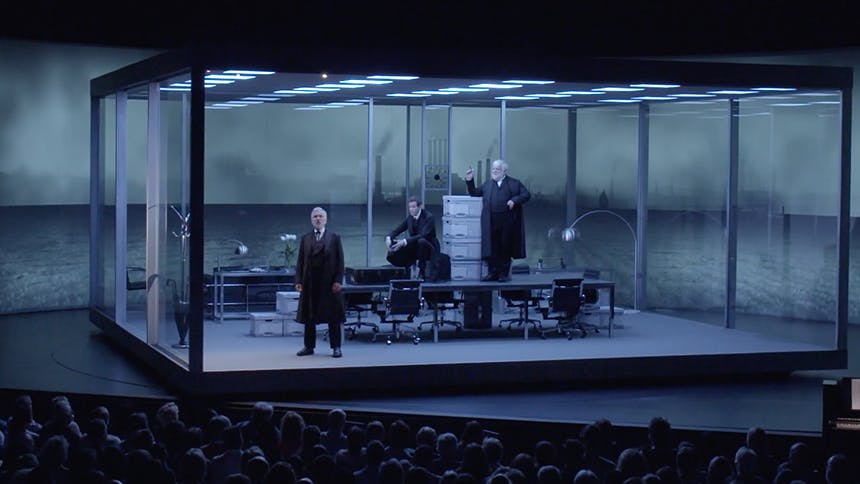
Two strikingly different styles of theater making can be seen by San Franciscans this week. The exquisitely fine-tuned production design of a big-budgeted American history play at A.C.T. offers a fascinating counterpoint to the rough-hewn, shoestring fun of Theatre Rhinoceros’ outdoor take on Shakespeare.
Here’s a peek behind the scenes of two ambitious productions with wildly divergent aesthetics.
A dramatization and an installation
“This show is promoted as having only three actors,” said veteran British production manager Jim Leaver, discussing director Sam Mendes’ and scenic designer Es Devlin’s sui generis manifestation of “The Lehmann Trilogy,” now playing at A.C.T.’s Toni Rembe theater. “But there are almost always more than three characters on stage.”
In fact, throughout the entrances and exits of the show’s three-man cast, which portrays successive generations of the Lehman financial dynasty from immigrant beginnings in antebellum Alabama to the market crash of 2008, two equally chameleonic figures remain ever-present.
The first is the music, played by an onstage pianist (Rebekah Bruce in the A.C.T. staging) who accompanies the entire three-hour plus production, with composer Nick Powell’s score, an ever-shifting swirl of genres, from Yiddish folk music to classical to ragtime to Eno-esque ambient.
The second—the production’s most celebrated star—is an enormous 800-square foot glass box that hovers above the stage floor, gleaming, rotating, and working in tandem with a cyclorama-style video backdrop (“15.5 million pixels,” emphasized Leaver in an interview with the Bay Area Reporter) to portray dozens of locations over the course of more than a century.
Beyond the script
Devlin, a brilliant conceptualist whose cross-pollenization of set design and sculpture has brought unexpected artfulness to arena pop shows (Kanye West’s flying wedge; U2’s “Innocence + Experience” and Sphere productions), has described her Lehman design as simultaneously a boxful of dreams and empty vessel; an apt dual metaphor for the rises and falls of American capitalism.
Leaver has supervised this monumental set piece’s construction, dismantlement, redesign and transport as the production has traveled between the New York, London, Los Angeles, Sydney, and now San Francisco over the past six years.
“The cube and the music bring very specific effects and textures to the performance,” said Leaver. “This production is one particular creative team’s very unique conception of the play.”
In fact, the original script, which was written in Italian by Stefano Massini, calls for only a few pieces of office furniture to create its setting. (The adaptation used here is by Ben Power, a dramaturg, playwright, and associate director of Britain’s National Theater) Prior to the 2018 debut of the Mendes-Devlin, international productions employed larger casts and considerably less infrastructure.
Seeing “The Lehman Trilogy” at A.C.T. will provide frequent theatergoers with a potent reminder of the distance between a script and a staged production. And of the richness offered by multi-disciplinary creativity.
Rhino charges down Castro

While the production of “The Lehman Trilogy” at A.C.T. requires exquisitely calibrated artistic control during every moment of stage time, Theatre Rhinoceros is pursuing a distinctly different approach to playmaking with a freewheeling al fresco take on Shakespeare’s “All’s Well That Ends Well,” which has its final four outings this Thursday through Sunday.
Over the course of each promenading performance, audiences of up to 35 accompany the show’s cast on an 8 block meander from the Rhino’s 18th Street space through a succession of neighborhood settings, including the Pink Triangle Park on Market Street and the heart of the Castro, standing in for the Italian Alps.
Artistic director John Fisher, another quintet of cast members and a wagon-rolling crew rehearsed their outdoor exploits over several weeks in advance of last Thursday’s first preview, one can never predict the serendipities of sidewalk performance, be it an audience that accumulates as the show progresses, or impromptu interaction with self-appointed extras.
“Shakespeare was written to be performed outdoors,” said Fisher in an interview with the Bay Area Reporter, “I wouldn’t want to do it otherwise.”
Taking it to the streets
In past years, Fisher has mounted Rhino’s annual Shakespeare plays (which he edits himself for brevity and clarity) at Yerba Buena center and Salesforce Park, relatively controlled outdoor venues. His initial plan was to stage “All’s Well That Ends Well” in Collingwood Park, but the city locks its gates before the show’s 7pm curtain time and refused to make an exception.
Fisher’s displeasure with that decision is part of what led to this year’s roving, regulation-eschewing approach, which he views, in part, as an expression of grassroots artistic freedom in the face of unreasonably restrictive public policy toward the creative community.
When another local queer theater company, EyeZen Productions, mounted its tribute to singer Sylvester in the Haight last summer, the city’s permitting fees added considerable expense to the production, making the undertaking a major challenge for a small community-focused organization.
In a city struggling to deal with a soaring cost of living and a depopulated urban core, Fisher says it’s counterproductive to put unnecessary constraints on the theater makers and other local artists who can help make San Francisco a more vibrant and engaging place to live.
